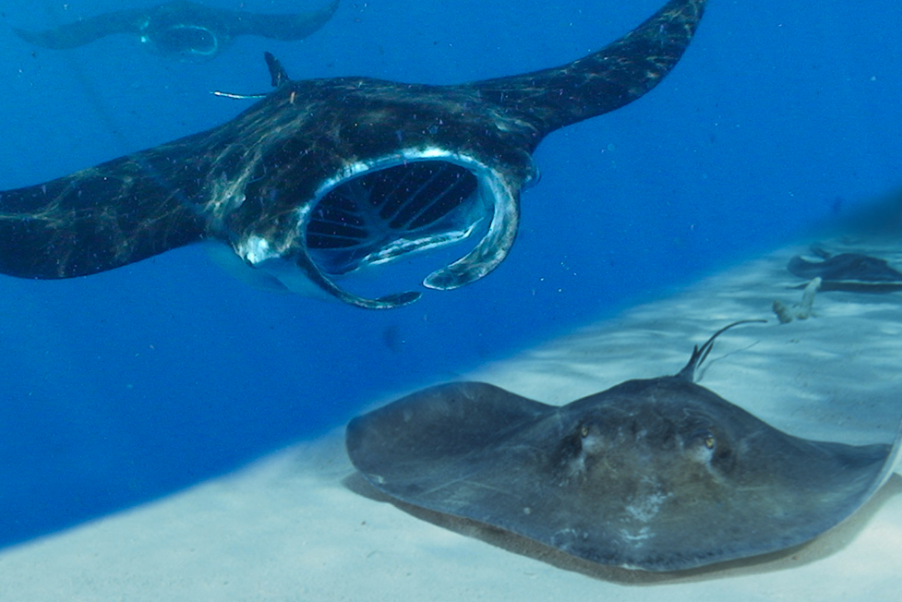Stingrays and Manta Rays: Differences and Myths

Discover the differences between manta rays and stingrays, their habitats, behavior, and how to interact with them safely in Cancun.
Manta rays and stingrays are two marine species often confused due to their similar shape and graceful swimming. However, they have notable differences in size, behavior, and habitat. There are also many myths about how dangerous they are, which should be clarified.
If you're interested in learning more about these species and where you can interact with them in Cancun, here you'll find detailed information.
What is the difference between a manta ray and a stingray?
Despite their similar appearance, manta rays and stingrays have significant differences.
Size and Appearance
Manta rays are much larger, with a wingspan that can exceed seven meters in some species. In contrast, stingrays are smaller, with sizes varying by species, typically ranging from 30 centimeters to two meters.
Fin Shape
Manta rays have large, triangular fins that allow for smoother movement, giving them the appearance of "flying" underwater. Stingrays, on the other hand, have more rounded fins that are closely attached to their bodies.
Mouth and Gills
Manta rays have their mouths located at the front of their bodies, while stingrays have theirs underneath. This is because stingrays usually feed on small organisms found on the ocean floor, whereas manta rays feed on plankton in open water.
Tail and Defense Mechanisms
Manta rays do not have stingers or venom, making them harmless to humans. Stingrays, however, can have a venomous barb on their tail, which they use only as a defense mechanism.
Habitat and Behavior
Manta rays live in the open ocean and typically swim in deeper waters. Stingrays prefer sandy bottoms and coastal reefs, where they can camouflage themselves to avoid predators.
Are Stingrays Dangerous?
There are many misconceptions about stingrays, especially regarding their aggressiveness. Here are some clarifications:
- Myth: "Stingrays attack humans"
Stingrays are not aggressive animals. Their venomous barb is only used as a defense mechanism when they feel threatened. Most accidents happen when someone steps on them by mistake. - Myth: "Manta rays also have venomous barbs"
Unlike stingrays, manta rays do not have a stinger or venom, making them completely harmless. - Myth: "Swimming with stingrays is dangerous"
In supervised environments like the Interactive Aquarium of Cancún, swimming with stingrays is a safe and educational experience. These animals are used to human interaction, and all visits follow proper safety protocols.

Where to See and Swim with Stingrays in Cancun
1. Interactive Aquarium Cancun
The Interactive Aquarium Cancun is the best place to get up close to stingrays in a safe and educational environment. Visitors can observe, touch, and feed stingrays while learning about their biology and conservation.
The aquarium also offers the Aquarium Trek experience, allowing you to walk underwater surrounded by marine life, offering a unique perspective of the ocean world.
Location: Plaza La Isla Shopping Village, Hotel Zone
2. Other Stingray Experiences in Cancun
- Snorkeling Tours: Some reef tours allow you to observe stingrays in their natural habitat.
- Marine Parks: Some theme parks offer stingray swimming experiences, although these are often less focused on education and conservation compared to the Interactive Aquarium.
Fun Facts About Manta Rays and Stingrays
- Manta rays can leap up to two meters out of the water—a behavior scientists still don’t fully understand.
- Some stingray species can bury themselves in the sand to hide from predators or ambush prey.
- Stingrays use electroreceptors on their snouts to detect the movement of their prey.
- Manta rays have the largest brain-to-body ratio of all cartilaginous fish, making them highly intelligent.
Experience It at the Interactive Aquarium Cancun
If you want to see stingrays up close and learn about their role in marine ecosystems, the Interactive Aquarium of Cancún offers one of the best hands-on experiences in a controlled and safe environment.
In addition to seeing and touching stingrays, you can take part in activities like Aquarium Trek, a helmet-diving adventure that lets you walk underwater surrounded by these fascinating creatures.




